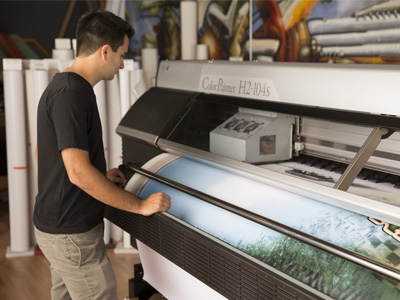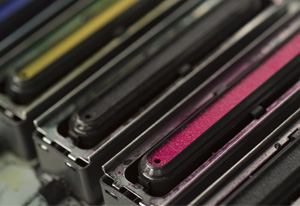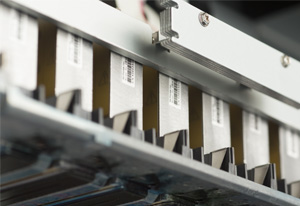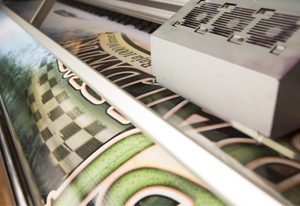Wide-format Graphics: Advances in inkjet technology
by all | 24 October 2014 3:24 pm
 [1]By Kelly Gornick
[1]By Kelly Gornick
Digital wide-format inkjet printing has become a mainstream tool of the sign industry. A sign shop’s specific choice of printer, however, as defined by the type of ink formulation used, speaks volumes about its priorities as a business.
With a solvent- or eco-solvent-based inkjet printer, for example, a sign shop is likely focusing on producing graphics that will last as long as possible outdoors, with consistently rich, glossy colours. It may also need to print high-resolution images on many different types of media. In this sense, sign shops usually buy such a printer to help expand their capabilities and potential productivity.
A durable aqueous ‘latex’ inkjet printer, on the other hand, suggests high-resolution indoor graphics are a sign shop’s ‘wheelhouse,’ with a prioritization of instantly dry output as customers demand quick turnaround. It also speaks to a high regard for environmental sustainability, as the inks contain no volatile organic compounds (VOCs), and respect for employees and customers who appreciate the lack of off-gassing.
Ultraviolet-curing (UV-curing) flatbed printers combine some of these features, as they can handle flexible or rigid substrates and provide instantly dry output. For many sign shops, they have yielded opportunities for new applications, from uncoated flexible banners to ceramic floor tiles.
That said, while each type of printer offers clear advantages and disadvantages, these differences have begun to narrow as printhead and ink technologies continue to evolve. This can make deciding which printer to buy more challenging when considering which types of applications to offer, determining how much productivity is required and calculating running costs.
Often overlooked in this purchasing process are the actual printing mechanics. There are several key elements in this regard that ensure a machine can properly fire ink onto the substrate, including not only the formulation of the ink itself, but also the engineering and programming of the printheads.
 [2]Ink formulations
[2]Ink formulations
When considering a wide-format printer upgrade, one of the best starting points is to calculate monthly ink costs. In many cases, an upgrade is justified on the basis of a larger volume of printing at a lower cost per square foot. It is not uncommon for sign shops to save between eight and 10 cents per square foot of ink coverage, running as few as three rolls of media per week, and realizing savings of $700 to $800 per month.
Some inks are more economical because their composition provides advantages that lead to savings. Indeed, inks that cost about the same per litre can differ significantly in true cost due to their composition.
High-viscosity inks, for instance, contain more pigment and are therefore thicker than other inks. The higher the pigment load, the smaller the amount of ink needed to print a specific colour. Indeed, high-viscosity inks can reduce overall use by up to 40 per cent.
Further, when ink lands on the substrate, it needs to adhere strongly to achieve sufficient durability for the intended application. An ink’s performance in this respect also affects cost.
In the past, for example, many water-based (aqueous) inks were environmentally friendly and quick to dry, but required special coated media to ensure proper adhesion. These substrate choices were not only expensive, but also limited.
Solvent-based inks, meanwhile, have a proven reputation for excellent outdoor durability, scratch resistance and media versatility, but as the harmful effects and noticeable odour of early ‘true solvent’ inks led to the development of ‘mild solvent’ and eco-solvent inks, there was a minor trade-off in media versatility. With this in mind, chemists continue to improve eco-solvent ink formulas to increase their performance across more materials.
Indeed, moving on from monthly ink costs, it is important to consider durability, versatility and other elements of ink performance. Quick-drying UV-curable and latex inks still cannot replicate the vibrant, glossy colours and outdoor durability of solvent inks.
Upgrades often become a no-brainer, however, when signmakers figure in the faster throughput, increased graphic quality and lower cost of production offered through today’s improved printheads.
 [3]
[3]When considering a wide-format printer upgrade, it is important to forecast monthly ink costs.
Printhead engineering
Printheads have a direct effect on the speed of a wide-format inkjet printer, which in turn relates directly to the profitability of the sign business. If a sign shop is producing output at 11.1 m2 (120 sf) per hour, for example, and could upgrade its printer to produce output of the same or better quality at 32.5 m2 (350 sf) per hour at similar cost, then it could become nearly three times more profitable.
Each printhead features hundreds of nozzles that can fire ink onto the substrate. There are several types in today’s digital wide-format inkjet printers, including thermal drop-on-demand, piezoelectric drop-on-demand and continuous inkjet (CIJ) printheads.
Thermal printheads are used in durable aqueous ‘latex’ printers. As their name suggests, they heat ink. Once the ink is heated, it ‘explodes’ and generates tiny droplets.
Piezoelectric printheads are used in eco-solvent and UV-curing printers and are so named because they contain a piezoelectric material (i.e. one that changes mechanically in response to an electric charge) within an ink-filled chamber behind each nozzle. Specifically, when a certain voltage is applied to the material, it changes shape so as to generate pressure on the fluid, forcing a droplet of ink to fire from the nozzle.
 [4]
[4]The engineering and programming of the printheads will be key in ensuring a printer can properly fire ink onto the substrate.
With CIJ printheads, a high-pressure pump directs the liquid ink out from a reservoir and onto the substrate, also using a piezoelectric material to break the ink up into droplets. Only some of the droplets are needed for actual printing; most are instead recycled within the machine.
Thermal printheads have a very simple structure compared to piezoelectric models, which makes them less expensive. They are also more frequently replaced. Another difference is there is no advantage in terms of speed when running thermal printheads at lower-resolution settings.
Industrial piezoelectric printheads are designed to achieve higher speeds, maintain better reliability and jet higher-viscosity inks. While they are more expensive, their longer life means they can help reduce running costs significantly, as they do not need to be replaced as frequently. This in turn can increase profits per square foot of output.
CIJ printheads can achieve very high printing speeds and their nozzles do not get clogged, as the jets are always operating. Solvent can evaporate while the drops are ‘in flight’ (i.e. after they are ejected from the nozzles and before most are recycled), so it is important to monitor ink viscosity and add more solvent to the reservoir as needed.
Most types of wide-format inkjet printheads now use some type of multi-drop or variable-drop technology to enable smaller droplets for printing fine details and larger ones at other times in the interest of speed. Some use multi-pass printing to eliminate banding (i.e. unwanted lines) by randomizing dot placement in optimized modes and across various substrates. And others are designed to compensate for any clogged nozzles, which helps keep printhead replacement costs and printer downtime at a minimum.
Printhead programming
The programming behind each printhead can be considered its ‘firing recipe,’ prescribing the optimum conditions in which to fire the inks specifically designed for use with that printhead.
 [5]This is why third-party inks do not usually perform as well as one would hope. Manufacturers of wide-format inkjet printers have the opportunity to optimize their printheads for use with their inks within their overall device. Further, they can optimize the post-print curing of the ink on the substrate, whether through volatilization, heat or UV radiation.
[5]This is why third-party inks do not usually perform as well as one would hope. Manufacturers of wide-format inkjet printers have the opportunity to optimize their printheads for use with their inks within their overall device. Further, they can optimize the post-print curing of the ink on the substrate, whether through volatilization, heat or UV radiation.
All of these factors have helped make today’s wide-format printers faster, more reliable and more economical than their predecessors. The evolution of inkjet printheads continues to push the boundaries for speed, ink waste reduction, image quality and substrate versatility, along with ink adhesion and print durability.
The future of printing
Sign shops, both big and small, will continue to realize the benefits of investing in new, more productive printers.
The chemists who formulate inks will continue to improve performance while avoiding VOCs and related odours. The engineers who design printheads will increase achievable resolution at high speeds. Some manufacturers will introduce larger printheads, while others will prefer to assemble arrays of smaller printheads.
Another trend that will continue is the enhancement of wide-format printers through the automation of procedures like printhead calibration and nozzle cleaning. These features have made the machines much easier to manage.
Kelly Gornick is a marketing communications specialist for Seiko Instruments USA, which manufactures wide-format printers. For more information, visit www.sii-printers.com[6].
- [Image]: http://www.signmedia.ca/wp-content/uploads/2014/10/Seiko_21434_LR.jpg
- [Image]: http://www.signmedia.ca/wp-content/uploads/2014/10/seiko_day223651_LR.jpg
- [Image]: http://www.signmedia.ca/wp-content/uploads/2014/10/Seiko_21389_LR.jpg
- [Image]: http://www.signmedia.ca/wp-content/uploads/2014/10/seiko_day223693_LR.jpg
- [Image]: http://www.signmedia.ca/wp-content/uploads/2014/10/Seiko_21430_LR.jpg
- www.sii-printers.com: http://www.sii-printers.com
Source URL: https://www.signmedia.ca/advances-in-inkjet-technology/